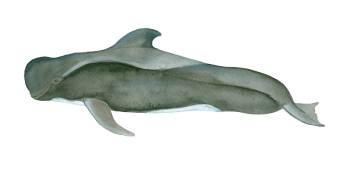
Short-finned pilot whale
(Globicephala macrorhynchus)
Pilot whales are very gregarious animals that live in tightly-knit units. Females exist in fixed matriarchal groups, pods of up to 20 individuals that may also unite with other pods to form groups of more than 100 individuals.
They can sometimes be seen in the company of other smaller cetaceans, particularly Bottlenose dolphins. Research suggests that pilot whales are capable of very high speeds when hunting in the deep, granting them the nickname “cheetahs of the ocean”.
The similar-looking Long-finned pilot whale (Globicephala melas) – which is practically impossible to distinguish from the Short-finned species at sea – also occurs in Madeiran waters.
General information
Further names: Portuguese: Baleia-piloto
Size of adults: 4 – 6 m
Prey: Mainly squid and occasionally smaller fish.
Behaviour: Very calm and gentle cetaceans. Occasionally approach our boats or curiously spy-hop at the surface. Often encountered resting for long periods at the surface between their dives, a behaviour commonly referred to as “logging”.
Range: Global distribution in temperate to tropical regions with a preference for deeper water. The long-finned pilot whale inhabits the temperate to subpolar waters of the Southern hemisphere and the Northern Atlantic.
Madeira: Frequently encountered, occur all year round.
Distinctive features: Dolphins with a round, globe-like forehead and no beak. Their sturdy, elongated body ranges in colour from dark-grey to jet-black. A paler heart-shaped marking can be seen in the chest area. The species has short, pointed flippers and a sickle-shaped dorsal fin with a wide base leaning towards the tail and positioned relatively close to the head. Very similar appearance to the long-finned pilot whale, that however inhabits colder regions and has longer flippers, extending over half their body length. Both species have a powerful blow which is easily visible with calm seas.
Taxonomy: Suborder: Odontoceti (Toothed whales), Family: Delphinidae (Dolphins)
Threats: They were hunted for centuries in the North-Western Pacific and are still killed in Japan and the Faroe Islands.
